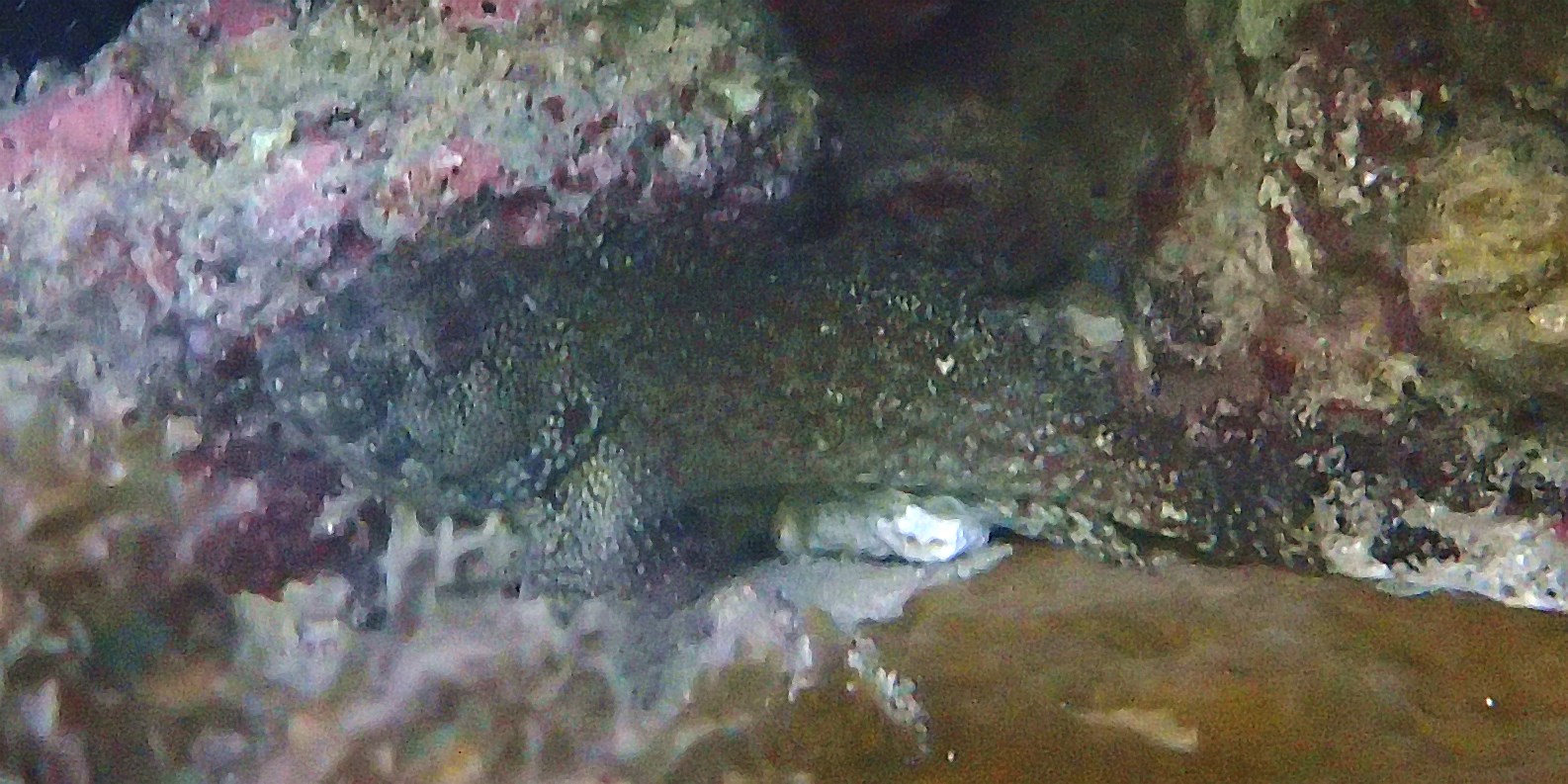



Labrisomus cricota/ conditus
| Ecological Descriptors | ||||
| Habitat | Size (cm) | Diet | Behaviour | Sex |
| R | 16/ 22 | Cru | Ter | F |
Description:
Difficult to distinguish between the 2 species of Mock and Masquerader Blennies: In the Mock Blenny (L. cricota), the first 3 leading spines of the dorsal fin are taller than the others, unlike with the Masquerader (L. conditus). Also see similar Hairy Blenny (L. nuchipinnis)
Body robust, head broad, snout blunt, eye large, with a long branched cirrus over each eye. Ocellus with white/ orange ring on operculum, but the ring is broken, unlike in Hairy Blenny (L. nuchipinnis).
Mock Blenny (L. cricota):
Both sexes: body with 4-5 conspicuous dark bars and fainter bars between them, all bars extend onto dorsal and anal fins, bars on dorsal fin reach outer edge of fin: a well developed ocellus on operculum with a broken white ring. No dark blotch at front of dorsal fin. First 3 leading spines of the dorsal fin are taller than the others
Male: Body olive-grey, head olive, with blue-green spots on cheek and snout; lower head and chest red, pelvics red.
Female: Body violet- grey to grey-brown, lower head, chest and pelvics grey-brown, with irregular pale patches on lower side of head and throat.
Masquerader Blenny (L. conditus):
Both sexes: body grey to red-brown to very dark brown, with 4 irreaular dark bars, with fainter and shorter bars between those, often a 5th bar on tail base; light blue dots on head, body and dorsal, anal and tail fins, interspersed with greenish blotches on body and dorsal fin. Dorsal fin spines of similar length. Irregular, poorlv defined, blackish blotch on upper corner of operculum partly edged by an incomplete, diffuse thick orange ring;
Male: head grey to red-brown to dark brown, cheeks mottled yellow-brown; chin through chest and belly yellow-brown: opercular orange edging relatively strong: dorsal fin dark on inner part paler outer part, without dark blotch at front:
Female: many more blue spots, especially on head and chest.
Ecology
Occur on rocky bottom with algal growth. It forages on benthic and algae-dwelling crustaceans, mostly amphipods. Males defend territories and probably tend harems. Sexually dimorphic during breeding season.
Life Cycle
Lays eggs in the benthos. Larvae have a pelagic phase before reaching maturity.
Difficult to distinguish between the 2 species of Mock and Masquerader Blennies: In the Mock Blenny (L. cricota), the first 3 leading spines of the dorsal fin are taller than the others, unlike with the Masquerader (L. conditus). Also see similar Hairy Blenny (L. nuchipinnis)
Body robust, head broad, snout blunt, eye large, with a long branched cirrus over each eye. Ocellus with white/ orange ring on operculum, but the ring is broken, unlike in Hairy Blenny (L. nuchipinnis).
Mock Blenny (L. cricota):
Both sexes: body with 4-5 conspicuous dark bars and fainter bars between them, all bars extend onto dorsal and anal fins, bars on dorsal fin reach outer edge of fin: a well developed ocellus on operculum with a broken white ring. No dark blotch at front of dorsal fin. First 3 leading spines of the dorsal fin are taller than the others
Male: Body olive-grey, head olive, with blue-green spots on cheek and snout; lower head and chest red, pelvics red.
Female: Body violet- grey to grey-brown, lower head, chest and pelvics grey-brown, with irregular pale patches on lower side of head and throat.
Masquerader Blenny (L. conditus):
Both sexes: body grey to red-brown to very dark brown, with 4 irreaular dark bars, with fainter and shorter bars between those, often a 5th bar on tail base; light blue dots on head, body and dorsal, anal and tail fins, interspersed with greenish blotches on body and dorsal fin. Dorsal fin spines of similar length. Irregular, poorlv defined, blackish blotch on upper corner of operculum partly edged by an incomplete, diffuse thick orange ring;
Male: head grey to red-brown to dark brown, cheeks mottled yellow-brown; chin through chest and belly yellow-brown: opercular orange edging relatively strong: dorsal fin dark on inner part paler outer part, without dark blotch at front:
Female: many more blue spots, especially on head and chest.
Ecology
Occur on rocky bottom with algal growth. It forages on benthic and algae-dwelling crustaceans, mostly amphipods. Males defend territories and probably tend harems. Sexually dimorphic during breeding season.
Life Cycle
Lays eggs in the benthos. Larvae have a pelagic phase before reaching maturity.


Masquerader Blenny


316

